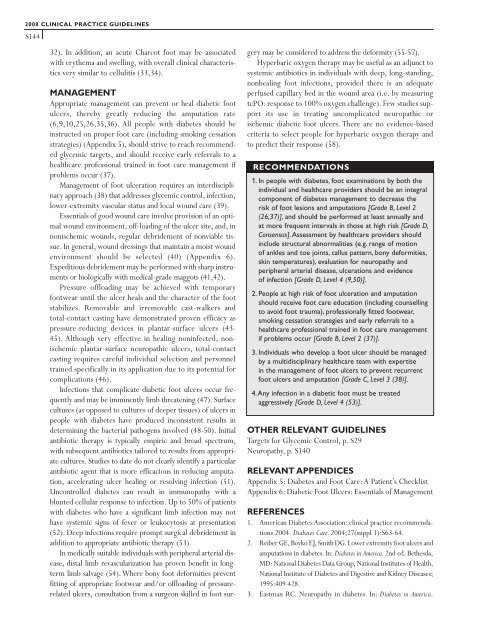2008 Clinical Practice Guidelines - Canadian Diabetes Association
2008 Clinical Practice Guidelines - Canadian Diabetes Association
2008 Clinical Practice Guidelines - Canadian Diabetes Association
Create successful ePaper yourself
Turn your PDF publications into a flip-book with our unique Google optimized e-Paper software.
<strong>2008</strong> CLINICAL PRACTICE GUIDELINES<br />
S144<br />
32). In addition, an acute Charcot foot may be associated<br />
with erythema and swelling, with overall clinical characteristics<br />
very similar to cellulitis (33,34).<br />
MANAGEMENT<br />
Appropriate management can prevent or heal diabetic foot<br />
ulcers, thereby greatly reducing the amputation rate<br />
(6,9,10,25,26,35,36). All people with diabetes should be<br />
instructed on proper foot care (including smoking cessation<br />
strategies) (Appendix 5), should strive to reach recommended<br />
glycemic targets, and should receive early referrals to a<br />
healthcare professional trained in foot care management if<br />
problems occur (37).<br />
Management of foot ulceration requires an interdisciplinary<br />
approach (38) that addresses glycemic control, infection,<br />
lower-extremity vascular status and local wound care (39).<br />
Essentials of good wound care involve provision of an optimal<br />
wound environment, off-loading of the ulcer site, and, in<br />
nonischemic wounds, regular debridement of nonviable tissue.<br />
In general, wound dressings that maintain a moist wound<br />
environment should be selected (40) (Appendix 6).<br />
Expeditious debridement may be performed with sharp instruments<br />
or biologically with medical-grade maggots (41,42).<br />
Pressure offloading may be achieved with temporary<br />
footwear until the ulcer heals and the character of the foot<br />
stabilizes. Removable and irremovable cast-walkers and<br />
total-contact casting have demonstrated proven efficacy as<br />
pressure-reducing devices in plantar-surface ulcers (43-<br />
45). Although very effective in healing noninfected, nonischemic<br />
plantar-surface neuropathic ulcers, total-contact<br />
casting requires careful individual selection and personnel<br />
trained specifically in its application due to its potential for<br />
complications (46).<br />
Infections that complicate diabetic foot ulcers occur frequently<br />
and may be imminently limb threatening (47). Surface<br />
cultures (as opposed to cultures of deeper tissues) of ulcers in<br />
people with diabetes have produced inconsistent results in<br />
determining the bacterial pathogens involved (48-50). Initial<br />
antibiotic therapy is typically empiric and broad spectrum,<br />
with subsequent antibiotics tailored to results from appropriate<br />
cultures. Studies to date do not clearly identify a particular<br />
antibiotic agent that is more efficacious in reducing amputation,<br />
accelerating ulcer healing or resolving infection (51).<br />
Uncontrolled diabetes can result in immunopathy with a<br />
blunted cellular response to infection. Up to 50% of patients<br />
with diabetes who have a significant limb infection may not<br />
have systemic signs of fever or leukocytosis at presentation<br />
(52). Deep infections require prompt surgical debridement in<br />
addition to appropriate antibiotic therapy (53).<br />
In medically suitable individuals with peripheral arterial disease,<br />
distal limb revascularization has proven benefit in longterm<br />
limb salvage (54).Where bony foot deformities prevent<br />
fitting of appropriate footwear and/or offloading of pressurerelated<br />
ulcers, consultation from a surgeon skilled in foot sur-<br />
gery may be considered to address the deformity (55-57).<br />
Hyperbaric oxygen therapy may be useful as an adjunct to<br />
systemic antibiotics in individuals with deep, long-standing,<br />
nonhealing foot infections, provided there is an adequate<br />
perfused capillary bed in the wound area (i.e. by measuring<br />
tcPO2 response to 100% oxygen challenge). Few studies support<br />
its use in treating uncomplicated neuropathic or<br />
ischemic diabetic foot ulcers. There are no evidence-based<br />
criteria to select people for hyperbaric oxygen therapy and<br />
to predict their response (58).<br />
RECOMMENDATIONS<br />
1. In people with diabetes, foot examinations by both the<br />
individual and healthcare providers should be an integral<br />
component of diabetes management to decrease the<br />
risk of foot lesions and amputations [Grade B, Level 2<br />
(26,37)], and should be performed at least annually and<br />
at more frequent intervals in those at high risk [Grade D,<br />
Consensus].Assessment by healthcare providers should<br />
include structural abnormalities (e.g. range of motion<br />
of ankles and toe joints, callus pattern, bony deformities,<br />
skin temperatures), evaluation for neuropathy and<br />
peripheral arterial disease, ulcerations and evidence<br />
of infection [Grade D, Level 4 (9,50)].<br />
2. People at high risk of foot ulceration and amputation<br />
should receive foot care education (including counselling<br />
to avoid foot trauma), professionally fitted footwear,<br />
smoking cessation strategies and early referrals to a<br />
healthcare professional trained in foot care management<br />
if problems occur [Grade B, Level 2 (37)].<br />
3. Individuals who develop a foot ulcer should be managed<br />
by a multidisciplinary healthcare team with expertise<br />
in the management of foot ulcers to prevent recurrent<br />
foot ulcers and amputation [Grade C, Level 3 (38)].<br />
4.Any infection in a diabetic foot must be treated<br />
aggressively [Grade D, Level 4 (53)].<br />
OTHER RELEVANT GUIDELINES<br />
Targets for Glycemic Control, p. S29<br />
Neuropathy, p. S140<br />
RELEVANT APPENDICES<br />
Appendix 5: <strong>Diabetes</strong> and Foot Care: A Patient’s Checklist<br />
Appendix 6: Diabetic Foot Ulcers: Essentials of Management<br />
REFERENCES<br />
1. American <strong>Diabetes</strong> <strong>Association</strong>: clinical practice recommendations<br />
2004. <strong>Diabetes</strong> Care. 2004;27(suppl 1):S63-64.<br />
2. Reiber GE, Boyko EJ, Smith DG. Lower extremity foot ulcers and<br />
amputations in diabetes. In: <strong>Diabetes</strong> in America. 2nd ed. Bethesda,<br />
MD: National <strong>Diabetes</strong> Data Group, National Institutes of Health,<br />
National Institute of <strong>Diabetes</strong> and Digestive and Kidney Diseases;<br />
1995:409-428.<br />
3. Eastman RC. Neuropathy in diabetes. In: <strong>Diabetes</strong> in America.











